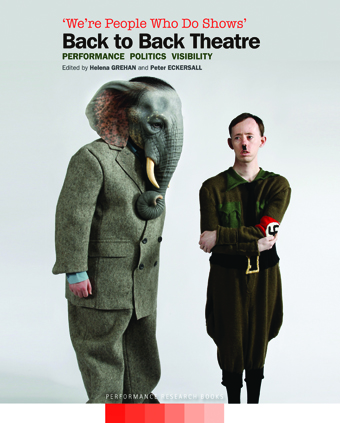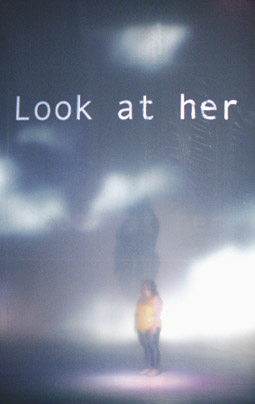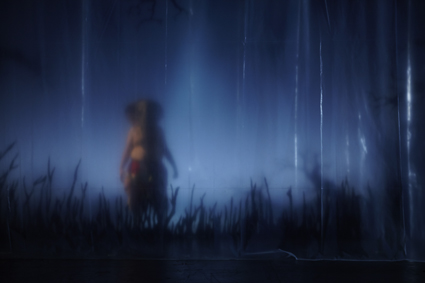We go to places you can’t go / in real life.
Keith Gallasch: Book, ‘We’re People Who Do Shows,’ Back to Back Theatre
 Here is a true rarity, an Australian book celebrating the long life and distinctive vision of a theatre company—Geelong’s internationally successful Back to Back Theatre ensemble. Rather than its works being playwright-driven, the company is an exemplar of contemporary performance, teaming an intensely collaborative director, designers and composers with performer-devisors with perceived intellectual disabilities to collaborate over very long periods on creations that unsettle our sense of time, space, identity and, not least, ability.
Here is a true rarity, an Australian book celebrating the long life and distinctive vision of a theatre company—Geelong’s internationally successful Back to Back Theatre ensemble. Rather than its works being playwright-driven, the company is an exemplar of contemporary performance, teaming an intensely collaborative director, designers and composers with performer-devisors with perceived intellectual disabilities to collaborate over very long periods on creations that unsettle our sense of time, space, identity and, not least, ability.
Published in the UK by the Centre for Performance Research in Wales, ‘We’re People Who Do Shows,’ Back to Back Theatre, has been ingeniously edited by Helena Grehan (writer, lecturer, School of Social Sciences and Humanities, Murdoch University) and Peter Eckersall (writer, dramaturg, Associate Professor, School of Culture and Communication, University of Melbourne). It’s a one-stop shop for scripts, interviews, artist statements, personal recollections, documentary history and complex academic analyses, an excellent collection of images, many by the great Melbourne photographer Jeff Busby, and admirably spacious design (Lin Tobias of La Bella Design, Melbourne) along with some fun touches like two brief flicker picture book series. I was surprised that ensemble performers are not always identified in photo credits, although the reader can sometimes make guesses based on discussions about roles in the essays.
The editors’ aim was to “create an archive” that is “multilayered and sensory or what Walter Benjamin calls ‘the mosaic’: ‘an immersion in the most minute details of the material content.’” They also saw the book as “dramaturgical,” “presenting a range of speaking positions juxtaposing image and text, creative and critical modes of response as well as….insights into the production process.” Further, the works would be “analysed through the lens of new media dramaturgy because it explores theatre’s compositional elements in relation to mediatisation and visuality.” These are frameworks within which Back to Back’s performances are so powerfully realised, conjuring associations with performance makers Romeo Castelluci, Robert Wilson, Hotel Pro Forma and light artist James Turrell, a key influence in recent works says Back to Back artistic director Bruce Gladwin in a long, wide-ranging interview with Performance Research director Richard Gough.
The editors certainly fulfil their ambitions in a book that views the company from numerous angles, inside and out. There is no literal account of the company’s history from 1987 save for a handy list of productions, each with an image and credits for the creative team, but in “In conversation,” previous directors meet with Gladwin and talk through Back to Back’s emergence and struggles for recognition. They recount how some support for the work came from a period of “normalisation,” which aimed to get people with disabilities out of institutions (“and save money”); a time when performers were allowed to move on stage but not speak; the discovery that one of the performers, Rita Halabarec, was a gifted writer (her piece Assembly is reproduced a few pages later); and the push to move from being “a sort of disability organisation” to getting support from the Theatre Board of the Australia Council as a company in its own right, which it became in 1997. The company developed as it engaged with Deakin University’s Woolly Jumpers Theatre-in-Education company, Handspan, Arena Theatre and Circus Oz, always developing skills, maintaining continuity and, as Gladwin puts it, “finding those mechanisms to get the best from people…the best framework to support them on stage and in the process of creating something.” The emphasis on democratic processes is emphatic: Gladwin talks about the importance of “hanging out,” sitting, chatting and “then we’d get up and try something.” Barry Kay recalls learning to focus on the “level playing field” of play. Ian Pidd remembers “always trying to push [performers] beyond their comfort zone,” a goal that Gladwin iterates elsewhere in the book.
The academic essays in the book engage passionately with the works that have emerged from Bruce Gladwin’s artistic directorship—these are the focus of the book. ‘Passionately’ because it is evident that they are moved by these works, disturbed by their capacity to deal directly with big issues and with a deeply unsettling ambiguity. Lalita McHenry, writing about SOFT (2002), approaches the work in terms of empathy, specifically Emmanuel Levinas’ notion of “Substitution—putting oneself in place of another.” At the end of SOFT we are left “face to face with the last man with Down Syndrome”—the rest of his kind have been eliminated in a massive eugenics campaign—but in the work’s first half a couple with Down Syndrome baulk at having a child despite the fact that the doctor they meet has the condition too. We are being tested, even more so, says McHenry, by the design, a vast bubble in which we sit each with headphones: “We see and hear from the inside out, as if we, the audience, are not yet formed, not yet human…[in] a womb-like sculpture.” It’s a striking observation that explains the sheer strangeness of experiencing SOFT.
Eddie Paterson’s “Script after script: Back to Back and dramaturgy of becoming” observes that “in recent works the process of writing for performance comes increasingly to the fore…highlighting the connection with performance art and the collapsing distinctions between author, director, maker, performer and spectator.” Citing scholar John Freeman, Paterson sees this as “a textual playground, where nothing is sacrosanct.” More than that, he writes, the works resonate with Deleuze and Guattari’s notion of ‘becoming,’ in which “minoritorian subjects strategically rupture dominant notions of language and power.” He focuses on the banality of the dialogue in small metal objects (2005), noting reviewer Alison Croggon’s initial feeling that the show needed a strong writer but later realising that “the script they have serves their purpose adequately.” Equally the notion of sole authorship is dispensed with by Back to Back, reflecting the collaborative creation of the work. Besides, the dialogue “becomes poetic” with the punctuating rhythms of the sound score. In Food Court (2009) the spare, brutal deployment of language (spoken, projected, “unstable”) makes radical demands on the audience. In a step further, if with transparent dialogue (and in various languages), Ganesh Versus the Third Reich (2011) becomes a “meta-theatrical commentary” on the work’s creation and issues of ability, casting, power (political, directorial), race and exploitation. Paterson’s account very aptly describes Back to Back in terms of its own dramaturgical becoming.

Food Court, Back to Back Theatre
photo Jeff Busby
Food Court, Back to Back Theatre
Helena Grehan in “Responding to the unspoken in Food Court” like McHenry leads from Levinas: “we have no option but to respond to the call of the other” without any expectation of reciprocity. She writes, “While [the performers’] bodies and voices act as markers reminding spectators that they are disabled, the content and searing or (awful) power of their exchange compels us to think and feel beyond a focus (solely) on questions of dis/ability.” She adds, “this is not the other after all, this is a group of performers performing the ‘majority.’” She finds this “shattering,” “it disallows any bystanding,” and there is no “panacea for spectators.” Agreed, but the performance is surely also, in the dialectical manner so true to Back to Back, about people with disabilities maltreating others with disabilities—there is no escaping that. In the same essay, Grehan quotes Gladwin as saying he feels ‘“an incredible responsibility to present [artists with disabilities] in a positive light’ but that for this work the decision was ‘to let it be as dark as it was.’”
Caroline Wake and Bryoni Trezise, in their essay, the one most acutely focused on form, “Disabling Spectacle: Curiosity, contempt and collapse in performance theatre,” also attend to Food Court, in which, as in all of Back to Back’s work, “perception is all.” Spectators are asked “to consider perceptions of disability through performances of disability,” the resulting tension “startl[ing] them into a moment of self-conscious insight.” The work achieves this, they argue, because it is “a hybrid form of ‘performance theatre’” [presumably contemporary performance + theatre, in a work calculatedly staged in a theatre ] “unsettl[ing] the historical alignment between spectacle and spectatorship…keep[ing] spectators in a zone of deferred perception such that a fixed vision of either self or performer can never fully arrive.”
To this end Back to Back’s work has “avoided the framework of disability theatre,” a form in which the nature and sociology of disability is delineated. Instead the company has realised, write Wake and Trezise, “disability performance in which performance is called upon to denaturalise the naturalisation of disability as performed spectacle” in which actors “perform only their [disabled] selves.” The writers add depth to Paterson’s approach to language, focusing on the unexpected, reversals and inversions, the creating and undoing of perceptions. They detect in the production’s impressionistic scenology “the same liminal Zone that Bill Henson’s images occupy, what has been called in the context of Romeo Castellucci’s work the human/dis-human.” Here they argue that the “visuality of spectacle” is “forestalled” by projected text “both explaining and obscuring the action,” along with extreme contrasts in lighting, at turns distancing and immersive. They point to the power of the final bare image of a human body after Food Court has “hurl[ed] every possible theatrical tradition onto the stage” as if “the medium of performance theatre [has seemed] to turn against itself.” In a relentlessly shifting dialectic “the audience perceives performance theatre as simultaneously staging the spectacle of disability and,” as the writers pointedly if drolly express it, “the disabling of spectacle.”

Ganesh Versus the Third Reich, Back to Back Theatre
photo Zan Wimnberley
Ganesh Versus the Third Reich, Back to Back Theatre
Adding breadth to the editors’ appreciation of Back to Back’s collaborative approach is “Lighting Design: Between theatre and architecture, An interview with Andrew Livingston and Paul Jackson.” Helena Grehan couples an interview with Bruce Gladwin and an essay about the participatory video work The Democratic Set (2009), applauding it “as some small space of resistance to the troubled and bleak mainstream” critiqued by Henry Giroux. She captures well the sense of inclusiveness, shared responsibility and the “space of wonder” that the Democratic Set represents and the question it poses to all who make or watch it, “What is art?” Barry Laing reports on the “arrests” he suffered teaching a Back to Back Summer School, having to “change gear, slow down and somehow accommodate this voice: a voice that emerged as witty and irreverent and rich in imagination. This changed the way I was working.” As well, in their introductory essay, the editors condemn the unjust pressure (and lack of support from some key arts organisations) applied to Back to Back by a US-based fundamentalist Hindu organisation over the representation of Ganesh in the Melbourne Festival premiere of Ganesh Versus the Third Reich. Such crude opposition stood in the way of appreciating the work’s much needed insights.
Grehan in “Irony, Parody and Satire in Ganesh Versus the Third Reich” addresses audience complicity in a postmodern work which “positions its audiences in such a space of undecidability that it is difficult to know what ‘good’ spectatorship (in ethical terms) may entail. Fear of laughing at the wrong moment, wondering if the performers are behaving as they actually did in rehearsal or is this work parody, concern about your motives for seeing “a bit of freak porn” (as one of the ensemble, Scott Price, puts it), “feel[ing] empathy, at times a sense of embarrassment,” or sensing that “Scott’s frustration” with the dictatorial director is “very real” (despite the fictional frame)—are cumulatively unsettling. “We don’t want to be bad spectators; instead we want some idea of what it is we should be doing. There is no resolution.” Grehan sees Ganesh Versus the Third Reich as placing us ethically in a position of profoundly questioning the act of spectatorship, just as Wake and Trezise do in respect of perception and the play with forms.
In “Scott’s Aired a Couple of Things: Back to Back rehearse Ganesh Versus the Third Reich, ” Yoni Prior documents her experience of observing the development and rehearsal of the production, focusing on “the ways in which the company positions members of the ensemble as entirely legitimate professional artists, whilst claiming the authority of outsider artists to challenge the perceptions and representations of disability.” She details “an improvisation in which a serendipitous misinterpretation opened up unmarked territory between ‘what is fiction and what is not.’’’ And she adds another layer to the list of ambiguities perceptual and moral addressed in previous essays, writing “[to] borrow Richard Schechner’s distinction, Scott [in what is to become the scene mentioned above] is acting and not-not-acting in this moment as he performs a version of himself.”
In her conclusion, “Playing the reality line,” Prior writes, “The fact that the actors bear the unmistakable marks of disability generates both anxiety and excitement. They appear vulnerable and we who watch them are not always sure if they are safe [onstage]. We are not sure if they are in control, if they know what they are doing…we may be watching authentic distress rather than ‘good acting.’” However, “Ganesh Versus the Third Reich plays masterfully with ambiguities of ethics, meaning, control, intention and authenticity by confronting the audience with multiple challenges to their own ability to identify ‘the reality line.’” This means our stare is turned on us, she says: “the work glares back, remorselessly demanding an apologia from its audience, asking, ‘What are you looking at.’” Or, as in Grehan’s essay on Food Court, the question is presumably “Who are you?”
Tessa Scheer’s “The Impossible Fairytale, or Resistance to the Real” directly addresses the bodies of the performers in Ganesh Versus the Third Reich specifically in terms of their challenge to “the hegemony of the well-trained, socially approved ‘body beautiful’’’ and in the context of a well-established ‘Hollywood’ desire for the disabled to become the “honorary disable-bodied,” more ‘normal’ than different. Disturbed by audience members who preferred the work’s non-meta-theatrical scenes with their visible disabilities, Scheer thought she detected a desire to “favour the fairytale.”
Ensemble members, former and current (Rita Halabarec, Sonia Teuben, Nicki Holland, Simon Laherty, Brian Tilley, Sarah Mainwaring, Scott Price and Mark Deans) figure strongly in the book—in photographs, in essays and interviews where the power of their performances and their willingness to meet challenges are acknowledged— and in their ensemble statements—“We’re people who do shows/ We’re all quite short/ a little bit taller than the one before/ We’re agile and we work/ professionally in a theatre company” and “We’re not afraid to step into the cold, dark side./ At first we’re scared, but/ afterwards we feel good. We are witty, We are emotional. We go deep into the work./ We go to places you can’t go/ in real life.” Of course, many of the words in the scripts are theirs too, borne of exchanges or improvisation, or found, as they were for Food Court.
In New York, at the Under the Radar Festival in 2013, Scott Price and other ensemble members wrote and presented From Where I Stand which included the lines: “I can see the end of ultra-conservatism/ We will stand up in defiance, even though standing is difficult/ for some of us…And I can also see a post-disability world where there is an/ important place for everyone to occupy…”
‘We’re People Who Do Shows,’ Back to Back Theatre is a book for many people, at once accessible and erudite, intimate and esoteric, illuminatingly edited, illustrated and designed—a tribute to a great and enduring company, whose presence onstage we welcome again and again, greeting their difference as part of our lives, admiring their performances as we would any professional ensemble of high calibre and acknowledging the genius of Bruce Gladwin who shares his creative life with his talented ensemble, “providing the best framework to support them on stage and in the process of creating…” I thank Back to Back for taking me, as they write, “to places you can’t go / in real life.”
‘We’re People Who Do Shows,’ Back to Back Theatre, Performance, Politics, Visibility, editors Helena Grehan, Peter Eckersall, Performance Research Books, UK, 2013
RealTime issue #121 June-July 2014 pg. 38-39






